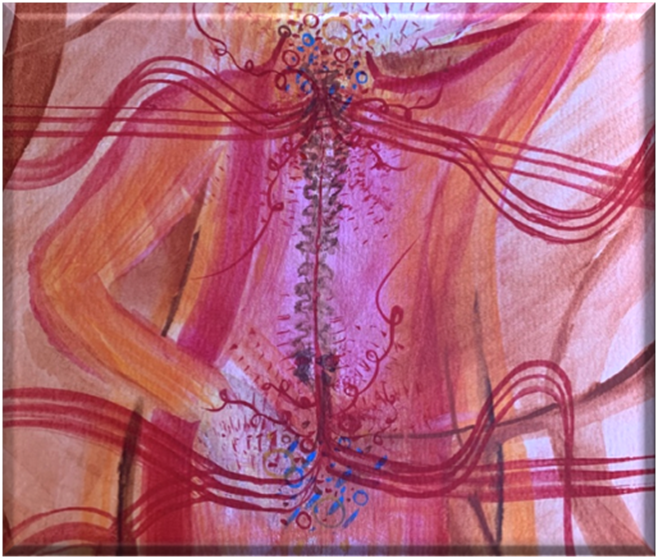Imagine my Pain
I was inspired by a clinical encounter during a GP consultation which included a female patient explaining what her pain felt like. This patient was particularly memorable because it was my first time hearing the lived-experience of someone with arthritis.
The GP asked her to describe the pain, after a moment of hesitancy she explained that she struggled to do day-to-day tasks. As the patient described how she felt immobilised and reliant on medications I felt very grateful to be trusted with such sensitive information.
Although it was a short conversation, it sparked an idea for a creative piece. I chose this encounter as communicating pain is so complex to translate. Recalling my own memories as a patient, it was difficult to find the ‘right’ words to express my pain – so learning about how we can understand the pain of others was an aspect I wished explore. We often find it difficult to describe pain as it also varies from person to person, and seems even harder to articulate when it is a new feeling.
The GP asked her to describe the pain, after a moment of hesitancy she explained that she struggled to do day-to-day tasks. As the patient described how she felt immobilised and reliant on medications I felt very grateful to be trusted with such sensitive information.
Although it was a short conversation, it sparked an idea for a creative piece. I chose this encounter as communicating pain is so complex to translate. Recalling my own memories as a patient, it was difficult to find the ‘right’ words to express my pain – so learning about how we can understand the pain of others was an aspect I wished explore. We often find it difficult to describe pain as it also varies from person to person, and seems even harder to articulate when it is a new feeling.
I chose to use watercolour as my creative medium due to their delicate and fluid qualities.
Painting, I find, encourages introspection, focus and imagination. I chose to use warmer tones alongside darker ones to represent the individual who experiences the pain and is not taken over by it. Depicting different patterns at the site of pain represents how varied individual experiences can be and therefore no single ‘best approach’ to routinely follow.
Effective Consulting, Year One, 2021
Comments
Add legacy comments here

“Imagine My Pain” is a powerful piece that resonates deeply with the emotional journey of both patients and healthcare professionals. As a medical student, I found the artwork’s representation of the challenges patients face in expressing their pain and struggles to be profoundly moving and applicable to my own encounters with patients. The dark watercolors bleeding together perfectly illustrate the difficulty patients face when trying to articulate their pain to healthcare providers. The amalgamation of colors conveys the tangled and intricate nature of these emotions, mirroring the complexities often hidden behind a patient’s stoic facade.
This artwork serves as a poignant reminder of the responsibility healthcare professionals bear in deciphering these emotions. It emphasises the importance of cultivating a space where patients feel safe to express their vulnerabilities. Understanding the intricacies of a patient’s pain is crucial in providing effective and empathetic care.
Those of you interested in this area may like to check out this website:
https://www.believemypain.com/
I really like this piece as it shows how difficult it can be for patients to communicate the pain they are feeling accurately to a doctor and how this can make consultations as a doctor more challenging. It shows the importance of giving patients the time and opportunity to explain themselves as fully as possible and how this can allow them to be more open and vulnerable.
I think that this is a really interesting concept as it is not something I have really considered much before. After reading the description, I realised actually how difficult it can be for doctors to understand the patients pain and how vulnerable a patient is in this moment. I think this piece also highlights the importance of maintaining the trust of doctors and healthcare professionals, as the patient needs to feel that the doctor is taking them and their pain seriously. I love the colours used in this piece and the use of the patterns to demonstrate that pain is not a simple feeling and can sometimes be quite intricate and difficult to describe.